2009 FLW Walleye Tour preview
One of the Great Lakes, two reservoirs and two rivers within a 1,000-mile expanse in the heart of walleye nation are the sites for the 2009 FLW Walleye Tour
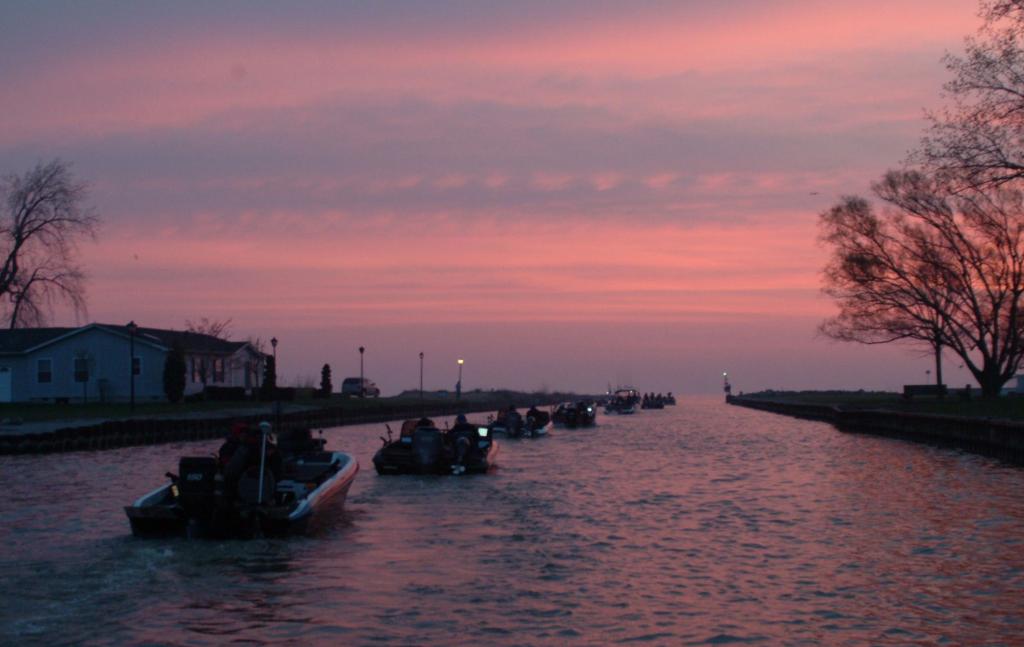
A diverse and travel-friendly schedule has pro walleye fishermen anticipating the coming Walmart FLW Walleye Tour season.
The tour begins April 15-18 on Lake Erie at Port Clinton, Ohio, continues May 6-9 on the Mississippi River at Red Wing, Minn., stays in Minnesota for a June 10-13 event on Leech Lake before heading to Wisconsin for the last qualifier July 15-18 on Lake Winnebago. Eligible pros and co-anglers then will wrap up the season with the FLW Championship Sept. 30-Oct. 3 on the Missouri River at Bismarck.
Leech Lake is a new site this year. The tour has been to Lake Erie six times, the Mississippi River at Red Wing three times and Lake Winnebago and the Missouri River at Bismarck once each.
“I’m excited about the whole <a href="http://walleyetour.flwoutdoors.com/schedule.cfm?cid=5&did=0
“>schedule,” said Stevens Point, WIs. pro Jason Przekurat, who has a win and 10 top-10 finishes in a nine-year FLW career. “It’ll be nice to start on Erie and whack some big fish. Then it’s on to Red Wing, where I won an event. Leech Lake will be fun. Here’s a fishery that was struggling in recent years and now is on a great rebound.”
Even though the economy is down, Sonny Reynolds, FLW Walleye Tour director, said he expects pro divisions at all events to be filled to the 150-boat maximum. Registration for pro anglers opened Jan. 27.
Lake Erie
Port Clinton, Ohio
April 15-18
Previous winners: Jim Klick (01), Dave Kolb (03), Carl Grunwaldt (04), Dean Arnoldussen (05), Dustin Kjelden (07), John Swanstrom (08).
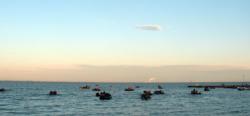
Check the angler profiles elsewhere on this web site and you’ll note that most touring pros have caught their all-time heaviest weight on Lake Erie. In six previous tournaments on the big lake the lowest winning weight was 40 pounds, 12 ounces, and that was in a 2001 tournament in which Day 2 was cancelled due to the weather. Otherwise the winning weight has been at least 62 pounds with the minimum average weight per fish in the winner’s bag at about 5 pounds.
John Swanstrom of Superior, Wis. won here last year with a whopping 143 pounds, 7 ounces, a new FLW Walleye Tour four-day cumulative weight record.
Trolling is the go-to tactic on Erie and last year Swanstrom used Reef Runners and in-line weights with spinners and crawlers to win.
“I tried to keep at least one Reef Runner in the water the whole time,” said Swanstrom, who was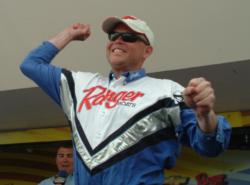 fishing on this circuit for the first time since the inaugural event on Green Bay in 2000. “But on the last day it was almost all spinners. One thing I’ll do this year is pay a lot more attention to current. You wouldn’t think it would be a factor on a big lake like Erie, but it’s a subtle thing that I feel really made a difference on the last day.”
fishing on this circuit for the first time since the inaugural event on Green Bay in 2000. “But on the last day it was almost all spinners. One thing I’ll do this year is pay a lot more attention to current. You wouldn’t think it would be a factor on a big lake like Erie, but it’s a subtle thing that I feel really made a difference on the last day.”
Walleye abundance and catch rates on Erie have declined in recent years due to below-average hatches since 2003, according to the Ohio Department of Natural Resources.
“However, the average size of fish caught in 2009 should be exceptional,” said Roger Knight, ODNR Lake Erie fisheries program manager.
The daily bag limit is four fish per person in March and April. A 15-inch minimum size limit is in effect during the entire season.
Mississippi River, pools 3, 4, 5
Red Wing, Minn.
May 6-9
Previous winners: Bruce Samson (02), Tom Keenan (03), Jeff Ryan (06), Jason Przekurat (07)
This part of the Mississippi River is a popular site for walleye tournaments ranging in size from small club outings to major national events. The FLW tour has been here four times, including twice for the championship.
Pools 3, 4, and 5 are popular because there’s a ton of fish in the system, including some monsters, and catch rates are good. Perhaps the most impressive tournaments FLW Outdoors hosted here were those in 2006 and 2007. In ’06, Jeff Ryan of Lakeview, Iowa won with 16 fish weighing 87 pounds, a 5.4 pound average, and in ’07 Jason Przekurat got his first tour win with 18 fish weighing 90 pounds, another hefty 5-pound average.
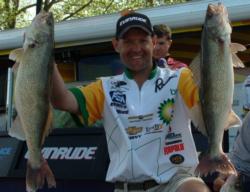 At the heart of the system is Lake Pepin, a 25,272 acre expanse of river that’s a mile wide and has an average depth of 20 feet. It’s a primary spawning area for walleyes and sauger, has abundant forage and fish with above average growth rates. Years 2006 and 2007 were especially good for both species, according to DNR surveys. An electrofishing survey last fall revealed that the average size of walleyes was 16 inches. A 29-incher also came to the surface. Among saugers, 24 inches was the biggest. That’s a big sauger, but not unusual for Lake Pepin, where Minnesota’s state record measuring 24 inches and weighing 6 pounds, 3 ounces was caught in 1988.
At the heart of the system is Lake Pepin, a 25,272 acre expanse of river that’s a mile wide and has an average depth of 20 feet. It’s a primary spawning area for walleyes and sauger, has abundant forage and fish with above average growth rates. Years 2006 and 2007 were especially good for both species, according to DNR surveys. An electrofishing survey last fall revealed that the average size of walleyes was 16 inches. A 29-incher also came to the surface. Among saugers, 24 inches was the biggest. That’s a big sauger, but not unusual for Lake Pepin, where Minnesota’s state record measuring 24 inches and weighing 6 pounds, 3 ounces was caught in 1988.
“We’ve seen some really impressive saugers the past few years,” said John Meerbeek, the DNR’s large lake specialist on Lake Pepin. “They’re a really important part of the fishery. The fishermen will have to decide if they want to target some sauger to fill out a good-sized limit.”
A variety of tactics work on this part of the river. Many anglers jig the deep holes or cast to shoreline riprap. Others pull crankbaits on planer boards or work wing dams with willow cats, a local minnow that’s deadly bait but which can be hard to find after hoards of tournament anglers hit the local shops.
Przekurat said current will be the deciding factor come tournament time.
“That and the water level, whether it’s low or high,” said the two-time FLW Angler of the Year.
Przekurat won here last year by fishing a small log jam near shore with jigs tipped with Berkley Gulp 4-inch minnows. “But for that spot to produce again,” he said, “things would have to be perfect. I’d say the odds are very slim.”
But odds are good the tournament will again be won by the pro who finds big fish in a small area. “A lot of the best river spots are small, one-boat areas,” Przekurat said, echoing comments made by Perry Good of Brainerd, Minn. after he won a Professional Walleye Trail event here in 2003 by fishing around a single, large boulder in a narrow, up-river channel.
Because they’re on the Minnesota-Wisconsin border water, pools 3, 4 and 5 are continuously open to walleye and sauger fishing. The daily limit is 6 fish with a minimum size length of 15 inches for walleyes.
Leech Lake
Walker, Minn.
June 10-13
Previous winners: none
Minnesota’s Leech Lake is new territory for the FLW Walleye Tour. Traditionally one of the best walleye lakes in the state, Leech suffered a dramatic decline beginning about six years ago and hasn’t hosted a major tournament since the PWT was here in 2002.
That tournament was won with a respectable 51.2 pounds, but Leech showed its other face in two other PWT tournaments, when the winning weights were 29.8 pounds in 1997 and 22.6 pounds in 1998. That ’98 tourney was won by Pete Harsh, 2008 FLW Angler of the Year, with the smallest winning weight in the PWT’s 19-year history.
Anglers can expect better bags this year. The lake’s walleye population has rebounded nicely, thanks to accelerated stocking and a reduction in the number of cormorants, a fish-eating bird that was nesting on Leech in large numbers and was blamed for decimating the walleye population.
At their peak in 2004, cormorants numbered about 10,000 on Leech. An average adult eats about one pound of fish per day, so it’s possible that cormorants were taking as many as 10,000 pounds of fish per day. How many of those were walleyes isn’t known, but the U.S. Department of Agriculture, Minnesota DNR and Leech Lake Band of Ojibwe began eradicating cormorants in 2004 by shooting adults and destroying their eggs. Since ’04, about 12,000 birds have been killed, said Doug Schultz, DNR large lake specialist.
“We’ve reached a point where we don’t have to shoot them in the summer anymore,” Schultz said. “Right now we estimate the population at 2,000 to 4,000, depending on the time of year.”
A cormorant diet study that began in 2005 is expected to be completed this year. The DNR will use the study to determine a Leech-specific population goal for the birds.
Meanwhile, the accelerated walleye stocking program that began in 2005 appears to have achieved its goal of restoring the lake’s walleye numbers in a hurry. Leech got 22.1 million fry in 2008, 7.5 million in 2007, 22 million in 2006 and 7.5 million in 2005. The Minnesota Legislature has mandated that Leech get 22.5 million fry both this year and in 2010, after which the stocking plan will be evaluated and probably halted, as the lake always had maintained good numbers of fish through natural reproduction.
From 2005 through 2007 Leech had great natural spawns to supplement the stocked fish. DNR surveys show the ’05 year class now measures 18 inches, the `06 class measures 14 inches and the `07 class measures 10 inches.
“All in all, things are fantastic right now,” Schultz said. “The lake has above average walleye densities.”
Come June 10-13, when FLW tournament pros descend on Leech, the walleyes will be in transition from spring to summer haunts, said Reggie Thiel, a Ranger pro who’s cashed a check in three of the four FLW events he’s fished since 2000.
“They could be deeper, more in the 20- to 30-foot range rather than the shallower water you find them in spring,” Thiel said. “But the bite should be good. If we get big winds they’ll be stacked up on the windy points. Crankbaits might come into play on the main lake and you might even see some caught on spinners.”
Leech is three lakes: Walker Bay, which is cold, clear and deep, the main lake, which is shallower and murkier, and Steamboat Bay, which runs about 8 feet deep and has lots of weeds. Walleyes thrive in all three, but Thiel said he expects most pros to key on the main lake.
Leech Lake has a protected slot of 18-26 inches with one fish over 26 inches allowed in a four-fish limit.
Lake Winnebago
Oshkosh, Wis.
July 15-18
Previous winner: Jamie Friebel (02)
A new law that took effect Jan. 1 allows the FLW to return to an inland lake in Wisconsin for the first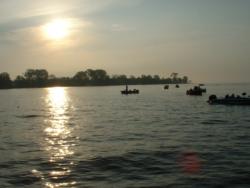 time since 2002. Wisconsin’s previous law forbade tournaments on inland waters from running for more than three consecutive days. The new law allows for four consecutive days.
time since 2002. Wisconsin’s previous law forbade tournaments on inland waters from running for more than three consecutive days. The new law allows for four consecutive days.
“We lobbied hard to get that changed,” Reynolds said of the old law. “We said, `Look, for the last day we only have 10 boats.’ ”
The last time the tour stopped at Lake Winnebago rookie Jamie Friebel of Hudson, WIs. won his first and only tour event. Second that year for the second straight tournament was Harsh. The two pros squared off on the final day in a classic clash of tactics, with Friebel rigging in the main lake while Harsh jigged in the river.
When it was over Friebel had six fish weighing 14 pounds, 2 ounces and Harsh had five fish weighing 11 pounds, 1 ounce. Chalk one up for the rookie over the old pro.
Now, after a seven-year absence, pros can expect to find a lake in which the fish populations are in very good shape, according to the Wisconsin Department of Natural Resources.
“Not only the walleyes, but everything else,” said Kendall Kamke, a senior fisheries biologist with the Wisconsin DNR in Oshkosh. “It’s hitting on all eight cylinders. Since 2001 we’ve had only three smaller than average (walleye) year classes. The others have been real good and it’s pumped up the walleye population.”
Last spring the DNR tagged 13,000 walleyes in order to track their seasonal movements, learn how many are being caught and to determine the total population. The most current estimate has the lake’s population of walleyes of 15 inches and longer at about 650,000.
Winnebago walleyes are unique in that they spawn on flooded vegetation instead of gravel rubble. By tournament time in mid-July most fish will be out of the marshes and into one of the four lakes that comprise the Winnebago system: Poygan, Winneconne, Butte des Morts and Winnebago proper. A forage base consisting of trout perch and young-of-the-year drum and white bass will be at peak numbers, meaning a lot of anglers will troll crankbaits and crawler harnesses to find schools of active fish.
Some pros say that going to Lake Winnebago in July isn’t optimal timing, but they might be surprised.
“It’s a reservoir system where the bite at that time should be phenomenal,” Reynolds said.
Przekurat agrees. “I fished a tournament there last July,” he said, “and it took 39 pounds — a 4-pound average — to win it.”
Unlike most inland lakes in Wisconsin, Winnebago is open year round to walleye fishing. This year anglers are allowed one sauger in a five-fish limit, though Kamke said he will recommend to the FLW that the tournament be walleyes-only.
Missouri River
Bismarck, N.D.
Sept. 30-Oct. 3
Previous winner: Tommy Skarlis (08)
Reynolds said last year’s FLW Walleye Tour championship on the Missouri River at Bismarck was “one of the best championships we’ve ever had, if not the best.”
It didn’t lack for drama, as the title was up for grabs until Tommy Skarlis of Waukon, Iowa, landed two 4-pounders to anchor a 13 pound, 10-ounce limit on the final day and nail down his first tour championship. Skarlis went into the final round of 10 in third place but leaped over second-place Todd Riley and first-place Ted Takasaki on day three and held on for the victory.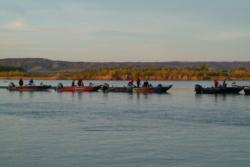
Skarlis found his winning spot during practice near the mouth of Beaver Creek, about a 45-minute ride from the launch site at MacLean Bottoms. He rigged and jigged the area in 5 to 11 feet and discovered the fish reacted best to live-bait rigs and nightcrawlers.
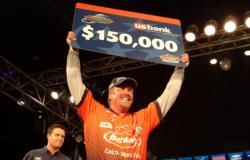 “The leaders got longer as the tournament went on because the fish got fickle,” Skarlis was quoted as saying. “The fish were relating to the old river bank and any stretch with gravel and wood was especially productive.”
“The leaders got longer as the tournament went on because the fish got fickle,” Skarlis was quoted as saying. “The fish were relating to the old river bank and any stretch with gravel and wood was especially productive.”
What will be the winning tactics on the year’s tournament trail? Who will qualify for the championship?
Those are two intriguing questions that will be answered in the coming months. Right now anglers are getting antsy to hitch up the boat and hit the road.
“I just drove home through 12 inches of snow,” Swanstrom said over the phone Feb. 3 from his home in Superior, WIs. “I’m really looking forward to starting at Erie.”